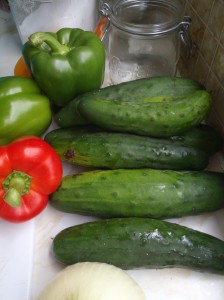 We’ve finally crunched the numbers: we weighed every gram of food we received from our CSA share at Tipi Creek, then found prices for equivalent goods from a farmers’ market and a grocery store.
We’ve finally crunched the numbers: we weighed every gram of food we received from our CSA share at Tipi Creek, then found prices for equivalent goods from a farmers’ market and a grocery store.
The results surprised me. I expected that the grocery store would be by far the cheapest, and that the CSA would be only slightly cheaper than the farmers’ market. In reality, the grocery store was marginally cheaper than the CSA, while the farmers’ market was much, much more expensive. The final costs were:
- CSA Cost: $600
- Farmers’ Market Cost: $1044.73
- Grocery Store Cost: $510.76
I was shocked to see how close the CSA and grocery store prices ended up. Obviously I always knew the farmers’ market was more expensive that the supermarket, but I didn’t think it was twice the cost. Yikes. These numbers make me want to give Ron and Yolande at Tipi Creek a hug.
All the raw numbers are in the spreadsheet at the bottom of this post. Before looking at the spreadsheet, please read the information below on our collection process and some sources of error.
The Data Collection
When weighing vegetables from the CSA, only the weight of the commonly used part of the vegetable was measured. The weights listed for beets, for example, are the weights of the root portion only, without the greens, even though the greens are good eats. This was done for easy comparison to grocery store items, which are usually sold leafless (it’s hard to keep the leaves looking fresh when they’ve travelled so far…) Other examples: kohlrabi leaves and carrot tops.
The grocery store prices were collected from the Garneau Safeway on Whyte Avenue in September. We used this store as it is our main source of groceries outside the CSA and farmers’ markets. From previous cost analysis projects, we know that this store is generally more expensive than others in the city (like the Sobey’s down the street). Most produce is sold at a set price per kilogram, which made data collection easy. Exceptions are parsley and radishes, which are sold in bunches of unmarked weight. These items required visual estimation, and may be a small source of error. All grocery store prices are for conventional produce, ie. not the more-expensive “organic” produce.
Farmers’ market prices were collected at the Old Strathcona Farmers’ Market from July through October. Because of the informal pricing scheme most vendors use, the farmers’ market prices are by far the least reliable numbers in the study. Only a few vegetables are sold by weight, most being sold per “bunch” or “bag”. To collect data we would find, for instance, a head of butter lettuce, and say, “That’s about how much butterleaf we got from the CSA this week,” and note the price. Not an exact science, clearly. Prices for given vegetables were fairly consistent among vendors. If there was a variance, we took the middle-of-the-road price.
Hidden Costs and Benefits of the CSA
There are some costs to the CSA outside the money paid at the beginning of the growing season: the gas used to drive to the farm and to the weekly pick-up location, and the time and resources spent processing the vegetables at home. Most of the vegetables have to be thoroughly washed. Freezing extra vegetables (a must when only two people are sharing the produce) requires blanching in boiling water, shocking in ice water, then plastic bags for storage. Items like leafy greens and herbs are loosely wrapped in paper towel and kept in an open plastic bag. We went through a lot of paper and plastic.
There is also the time spent working at the farm (four sessions lasting maybe three hours each). Of course, we think that time adds to the value of the CSA share. After all, you get to drive into the country, you can visit as you work, and some work days end in a potluck. I just thought I would mention the time for the sake of economic completeness.
Quality Factor
It should also be noted that the quality of produce received from the CSA and farmers’ market was of superior quality to the grocery store. This was especially true of carrots and corn.
The Data
Okay. With the formalities out of the way, feel free to peruse the raw data by clicking on the image below. Please let me know if you have any questions, comments, or suggestions for future data collection.
